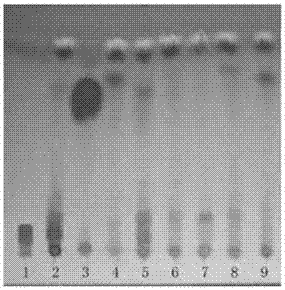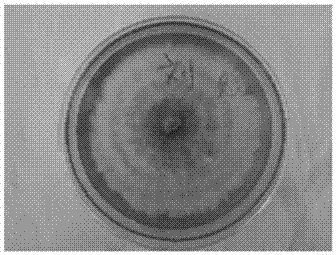A strain of Inonotus obliquus qd04 and method for transforming Polygonum cuspidatum into resveratrol, triterpene saponins and polysaccharides
A technology of Inonotus obliquus, QD04, which is applied in the fields of biotransformation and fermentation engineering of natural products, can solve problems such as uncontrollable conditions, pollution, and unknown flora, and achieve reduction of resource waste and environmental pollution, high nutritional value, and additional high value effect
- Summary
- Abstract
- Description
- Claims
- Application Information
AI Technical Summary
Problems solved by technology
Method used
Image
Examples
Embodiment 1
[0034] The screening method of Inonotus obliquus QD04 provided by the invention is:
[0035] 1) Screening of cellulase-secreting strains:
[0036] Thirteen kinds of medicinal fungi white rot fungi (collected and preserved by the Shandong Key Laboratory of Applied Fungi, Qingdao Agricultural University) were inoculated on cellulose-Congo red medium plates, cultured for 144 hours, and the diameter of the transparent circle (D) and the diameter of the colony were measured (d), in cm, see Table 1. The results showed that the D / d value of strains QD01, 02, 04, 06, 07 and 10 was greater than 1, which preliminarily judged that they might have strong ability to synthesize cellulase.
[0037] Table 1 Screening results of cellulase-producing strains on cellulose-Congo red plates
[0038] Strain number
144 hours transparent ring diameter
144 hours colony diameter
144 hours ratio of transparent circle to colony diameter
QD01
3.00
1.20
2.50
QD0...
Embodiment 2
[0045] Embodiment 2: Inonotus obliquus QD04 shake flask fermentation Polygonum cuspidatum
[0046] 1) Seed culture:
[0047] The formula of the seed medium is: according to the mass volume percentage, glucose 2%, peptone 0.5%, KH 2 PO 4 0.3%, MgSO 4 ·7H 2 O 0.15%, bran 0.5%, the balance is water, the liquid volume in a 250ml Erlenmeyer bottle is 50ml, and sterilized at 121°C for 20min.
[0048] Seed culture was carried out in a 250ml Erlenmeyer flask with a liquid volume of 50mL, a shaker rotation speed of 150rpm, a culture temperature of 28°C, and a culture time of 96 hours;
[0049] 2) Fermentation culture
[0050] Fermentation medium: add 3g bran and 100ml tap water to boil for 20min, filter, add water to the filtrate to 100ml, take 50ml and put it into a 250ml Erlenmeyer flask, add 2g knotweed powder (60 mesh), 1g sucrose, 0.25g peptone, KH 2 PO 4 0.15g, and MgSO 4 ·7H 2 O 0.075g, sterilized at 121°C for 20min.
[0051] The carbon source, nitrogen source and in...
Embodiment 3
[0054] Embodiment 3: Inonotus obliquus QD04 batch fermentation Polygonum cuspidatum
[0055] 1) Seed culture:
[0056] Seed culture medium and seed culture process are with embodiment 1.
[0057] 2) Fermentation culture
[0058] Fermentation medium: 35g bran and 1000ml tap water, boil for 20min, filter, add water to the filtrate to 1000ml, add Polygonum cuspidatum powder 60g / L (60 mesh), sucrose 10g / L, peptone 4g / L, KH 2 PO 4 2g / L, and MgSO 4 ·7H 2 O2g / L.
[0059] The fermentation culture uses a 5 L fermenter with a liquid volume of 3 L, an inoculum size of 10% (v / v), a fermentation temperature of 28 °C, a rotation speed of 300 rpm, an air volume of 1 vvm, and 5 mol / L NaOH Control the pH value to 6.0. The method of batch fermentation is adopted, and the fermentation is 8 days.
[0060] Experimental results: the conversion rate of resveratrol in the fermentation broth was 99.85%, the yield of triterpenoid saponins was 898.15±4.23μg / mL, and the yield of polysaccharides ...
PUM
 Login to View More
Login to View More Abstract
Description
Claims
Application Information
 Login to View More
Login to View More - R&D
- Intellectual Property
- Life Sciences
- Materials
- Tech Scout
- Unparalleled Data Quality
- Higher Quality Content
- 60% Fewer Hallucinations
Browse by: Latest US Patents, China's latest patents, Technical Efficacy Thesaurus, Application Domain, Technology Topic, Popular Technical Reports.
© 2025 PatSnap. All rights reserved.Legal|Privacy policy|Modern Slavery Act Transparency Statement|Sitemap|About US| Contact US: help@patsnap.com



